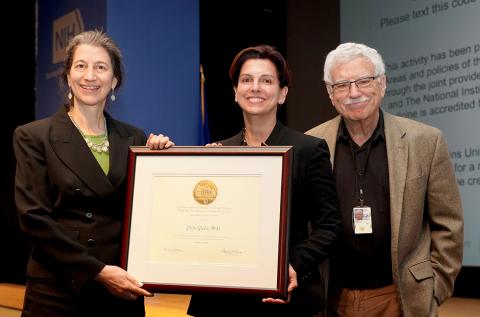The Multitudes Within
Ghedin Explores Our Inner Societies

Photo: Maria Maslennikov
There is bad news for the world’s solipsists. Our bodies are crowd scenes—whether you’re a hermit or a people person—and the types and number of characters we host can mean the difference between peace in the valley (health) and discordant strife (disease).
In her lecture on microbial networking, Dr. Elodie Ghedin, professor of biology and global public health and director of the Center for Genomics and Systems Biology at New York University, described the neighborhoods where viruses, bacteria and fungi cohabitate in our bodies, in both sickness and health.
“We no longer talk about one pathogen anymore, but about polymicrobial infection,” said Ghedin, who, in addition to having been a fellow in NIAID’s Laboratory of Parasitic Diseases from 1998 to 2000, was also a MacArthur Foundation awardee in 2011. “What we’d like to know is, does the microbiome contribute to disease severity?”
In a funny way, the behavior of our onboard microbes can be likened to the folks we live among in our neighborhoods, as Ghedin explored such roles as competition, parasitism, mutualism and synergism among our various microbiota. “It’s very difficult to capture” the way they interweave, she said.
Most work in the burgeoning field of microbiome studies has thus far focused on the gut. Ghedin is mainly interested in the genomics of infectious diseases affecting the lungs, respiratory tract and epithelium, and the myriad live-aboards in these sites.
Using postcard images of Kansas City and New York City, she showed that density can determine the number of interactions between microbes, a phenomenon she and her colleagues can map in the laboratory using such concepts as OTUs, or operational taxonomic units, a way of categorizing bacteria based on sequence similarity.
Fungi, a relatively common component of the human airway, add a fresh dimension of complication to investigations of interactions among host bacteria.
Ghedin calls these interactions “co-occurrence networks,” and they come in two flavors: direct, or physical contact, and indirect, wherein microbes modify their environments. “It’s like your network of Facebook friends,” she said.
One way of snooping on who’s where and doing what with whom is SPIEC-EASI, or sparse inverse covariance estimation for ecological association inference, Ghedin noted. “We can determine the stability of the [microbial] environment and how it relates to disease.”
As in the game of Jenga, wherein players construct a tower of blocks, then try to disassemble the edifice without collapsing the whole thing, scientists can study how the removal of single OTUs affects the stability of an ecosystem.
Ghedin’s team has found that fungi are crucial to the stability of the microbiome. Lung health is associated with more, rather than fewer, microbial interactions, even inter-kingdom ones, she said.
Scientists have also identified “influencers” and “disruptors.” Influencers tend to restructure microbial interactions, and include HIV, which promotes chronic obstructive pulmonary disease by encouraging Pneumocystis colonization. Disruptors, which change network connections, include the flu. “Influenza is a great disruptor,” Ghedin said.
For each disease she has studied, Ghedin has found signature ecologies, which she says are unique to specific conditions.
It will be valuable to be able to predict disease severity by sampling a patient’s microbiome, and mycobiome, she suggested.
“About 25 percent of the population [who come down with flu] develop severe disease,” said Ghedin. “We’re trying to understand why. Is there an age-determinant?”
It turns out that age is a strong determinant of microbial interactions. “The number is very different in neonates, versus adults, versus those who are aged.”
Fusobacterium, too, has emerged as an important hub in networks Ghedin has studied. It tends to lose its “neighbors,” or connections, in disease states.
Ghedin’s team is also studying antibiotic-resistance genes. They are collaborating in household studies of flu transmission among 120 people in Managua, Nicaragua, in an effort to find out if the upper respiratory tract might be the reservoir for antibiotic resistance.
“Our goal is microbiome-directed therapeutics,” she concluded.
Ghedin’s talk was this year’s Rolla Eugene Dyer Lecture, established in 1950 in honor of a former NIH director who was an authority on infectious diseases.
